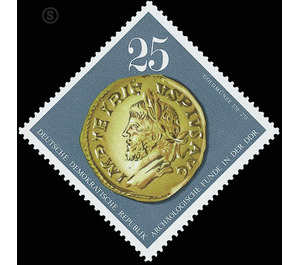Archaeological finds in the GDR - Germany / German Democratic Republic 1976 - 25 Pfennig
Theme: Economy & Industry
| Country | Germany / German Democratic Republic |
| Issue Date | 1976 |
| Face Value | 25.00 |
| Color | brown grey |
| Perforation | K 13 |
| Printing Type | Rotogravure 2 |
| Stamp Type | Postage stamp |
| Item Type | Stamp |
| Chronological Issue Number | 1926 |
| Chronological Chapter | GER-DDR |
| SID | 83825 |
| In 18 Wishlists | |
Archaeological finds in the German Democratic Republic The Ministry of Posts and Telecommunications of the German Democratic Republic publishes five multi-colored special postal stamps with illustrations of archaeological finds in the GDR. The special postage stamp issue "Archaeological finds in the GDR" presents scientifically and artistically remarkable objects. The motifs were selected from the collections of the museums of prehistory and early history Potsdam and Schwerin as well as from the Cultural History Museum of Stralsund. For the first time in the history of the German people, the socialist state protected the prehistoric and protohistoric landlords as historical and cultural heritage. Their preservation and care are among the most important tasks of historic preservation work, in the assistance of which the interested population is strongly encouraged to cooperate. Movable (so-called Bodenfunde) and immovable Bodenaltertümer (above ground grave and fortifications and the like) are the most important sources for research and teaching a scientific image of history from the beginnings of social development to the formation of the class society, i. in the GDR for a period of 350,000 BC. until the 13th century AD The preservation of these monuments, such as fortifications (ramparts, ramparts), burial places (megalithic and burial mounds), erect stones (so-called menhirs, stone crosses), old streets, settlements and cemeteries from prehistoric and early historical times (currently about 13,000 objects are recorded ) and their inclusion in the national culture form an important cultural task of the socialist society (Land Culture Act of June 1, 1970). As sources of historical research and as vivid witnesses of past periods, they are increasingly made accessible to tourism and popular education in a unity with the surrounding cultural landscape in archaeological reserves. Impressive examples are the groups of restored Neolithic megalithic tombs of Mecklenburg (especially on the Baltic coast), the stone crosses of Thuringia on hiking trails, the mighty Slavic castle walls of the Oder or Lusatia and their large Bronze Age burial mounds. Here, about 1,800 volunteer Bodendenkmalpfleger afford a scientifically valuable work. They have a significant share in the recovery and securing of nearly 77,000 prehistoric and prehistoric finds, which have been registered in the museums since 1954 alone and are partially exhibited after careful restoration. The Bodensekmalpflege is supported by the Academy of Sciences in Berlin, the Märkisches Museum Berlin and five museums of prehistory and early history in Dresden, Halle, Potsdam, Schwerin and Weimar in cooperation with the nature and home friends within the Kulturbundes. 25 Pfennig value: Roman gold coin (so-called aureus) of the Tetricus I. (270 to 273) of four seat, circle Rathenow The so far singular and very well preserved copy was presumably coined in Cologne or Trier and should have arrived as booty material to Germania , The coin is located in the Museum of Prehistory and Early History in Potsdam.


